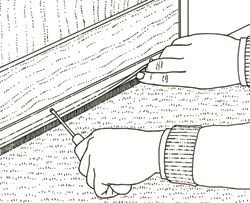Gillian Allder, director, Draught Proofing Advisory Association, urges developers and facilities managers to start at the beginning - with draught proofing.
Environmental performance is - or should be - top of the agenda for business and industry. Organisations must look at how efficiently they use the energy they purchase and consume.
However, it is not just climate change that is putting the emphasis on energy efficiency. Escalating fuel prices - to pay for the massive investment in renewable energy sources - and security of supply are of equal importance in the big picture.
Government has ambitious targets for reduction in CO
2 emissions. The Low Carbon Transition Plan (July 2009) sets out how government hopes to cut greenhouse gas emissions by 34 per cent by 2020, and by 80 per cent within 40 years. In the meantime Building Regulations will be progressively tightened this year and again in 2013 and 2016, as the government moves towards zero carbon construction for houses by 2016 and for industrial buildings by 2019 with earlier targets for schools and public buildings.
It is universally recognised that finding cost effective solutions in energy efficiency and sustainability is now a priority. The more energy efficient some parts of a building are, the greater the heat loss from under-insulated parts. There is often the misconception that installing carbon saving measures means higher costs. This is certainly not the case with top quality draught proofing measures approved to British Standards.
Draught proofing of windows and external doors is now recognised as an essential part of energy efficient design if optimum performance of other energy efficiency measures is to be achieved.

A draught-proofing strip on the bottom of a door
Benefits are immediately felt from implementing professionally installed draught proofing that can help bring buildings in line with current - and future - Building Regulations, together with meeting the demands of new legislation in relation to ventilation.
This includes the EU Energy Performance of Buildings Directive (EPBD), which requires buildings over 1000m
2 undergoing major renovation to also incorporate feasible energy efficiency improvements, coupled with energy certification.
Every government is required to apply a methodology, with characteristics of the building (shell and internal partitions, etc). These characteristics may include air-tightness, ventilation, natural ventilation and indoor climate conditions, including designed indoor climate.
Improving air-tightness reduces air leakage - the uncontrolled flow of air through gaps and cracks in the building fabric (sometimes referred to as infiltration, exfiltration or draughts). This is not to be confused with ventilation, the controlled flow of air into and out of the building through purpose-built ventilators, that is required for the comfort and safety of the occupants.
Too much air leakage leads to unnecessary heat loss and discomfort from cold draughts. With more stringent Building Regulations requiring better energy efficiency, air-tightness is an increasingly important issue. The aim should be to 'build tight - ventilate right'.
Buildings cannot be too airtight: it is however essential to ensure appropriate ventilation.
This is where draught proofing plays a crucial role in relation to heating installations and ventilation. Top quality British Standard draught proofing product specification incorporates requirements for fuel burning appliances, so as to avoid completely sealing a building and thus allowing the necessary gases from fuel burning appliances to escape.
If condensation exists in a building, measures need to be taken not to exacerbate the existing condition. In some cases this may need remedial work to be carried out before draught proofing is installed.
There will undoubtedly be an increased demand for draughtproofing to be put in place when heating installations are carried out to ensure the correct balance is achieved between ventilation and air-tightness, when meeting the requirements for energy efficiency.
Energy use through ill-fitting windows in older buildings is very commonplace. If draughtproofing is incorporated in any renovation work this can have a very beneficial effect on air leakage. In addition, there may well be a need for smaller boilers and fewer radiators to maintain the required temperature under new legislation.
The Code for Sustainable Buildings (CSB) sets out specified minimum performance requirements for energy, water and resource efficiency. It has established a series of performance levels: each will have clearly specified requirements. In stabilising these requirements all the principles of sustainable development will be taken into account.
To provide specifiers with a simple reference to properties, applications and standards of individual products recognised by the Draught Proofing Advisory Association (DPAA) and to aid selection, a Register of Approved Products has been produced by the association.
This is the first register to list quality draught proofing products suited to the commercial, industrial and architectural markets. This independent document offers considerable assistance to architects and designers, builders and others preparing specifications which incorporate draught proofing products.
Manufacturer members offer a comprehensive range of specialist threshold seals, weatherbars and draught excluders to satisfy all commercial and industrial building requirements for new build and refurbishment.
They can be approached for advice on window and door performance and how this can be affected: and on appropriate draught proofing for certain locations. Their laboratories are dedicated to testing windows and doors to the British Standard, often exceeding basic performance standards.
The DPAA has established a register of installers with the skills to draught proof commercial and industrial premises. They have agreed to ensure they use only appropriately skilled and trained staff to carry out any commercial or industrial draught proofing project accepted by them, to the specification.
Company literature is available free from member manufacturers, and stockists.
Literature on draught proofing applications, and a list of commercial contractors are readily available from:
Draught Proofing Advisory Association, PO Box 12, Haslemere, Surrey, GU27 3AH; tel: 01428 654011; e-mail:
dpaa@dpaa-association.org.uk web:
www.dpaa-association.org.uk.
1 March 2010